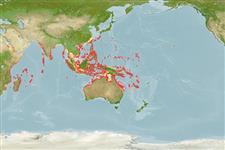Preferred temperature (Fonte Biblio.
123201): 25 - 29.3, mean 28.4 °C (based on 2439 cells).
Phylogenetic diversity index (Fonte Biblio.
82804): PD
50 = 0.7500 [Uniqueness, from 0.5 = low to 2.0 = high].
Bayesian length-weight: a=0.01995 (0.00956 - 0.04164), b=2.93 (2.76 - 3.10), in cm total length, based on LWR estimates for this (Sub)family-body shape (Ref.
93245).
Trophic level (Fonte Biblio.
69278): 3.3 ±0.6 se; based on diet studies.
Resilienza (Fonte Biblio.
120179): Medio, tempo minimo di raddoppiamento della popolazione 1.4 - 4.4 anni (Fec = 200).
Fishing Vulnerability (Ref.
59153): Low vulnerability (10 of 100).
🛈
Nutrients (Ref.
124155): Calcium = 79.6 [34.6, 217.9] mg/100g; Iron = 0.822 [0.365, 1.964] mg/100g; Protein = 18.1 [15.8, 20.3] %; Omega3 = 0.121 [0.056, 0.249] g/100g; Selenium = 28.3 [13.4, 65.1] μg/100g; VitaminA = 79.6 [22.6, 288.7] μg/100g; Zinc = 1.51 [0.97, 2.44] mg/100g (wet weight);
